Podcast
Questions and Answers
What term is used to describe the developmental stage beginning from the ninth week of gestation?
What term is used to describe the developmental stage beginning from the ninth week of gestation?
- Blastocyst
- Embryo
- Zygote
- Fetus (correct)
Which hormone is NOT involved in regulating the female monthly cycle?
Which hormone is NOT involved in regulating the female monthly cycle?
- Follicle-stimulating hormone (FSH)
- Luteinizing hormone (LH)
- Estrogen (correct)
- Gonadotropin-releasing hormone
During which process does the fertilized egg transition through multiple stages before implantation?
During which process does the fertilized egg transition through multiple stages before implantation?
- Mitosis (correct)
- Developmental cleavage
- Embryonic folding
- Gamete approximation
Which stage comes immediately after fertilization in early human development?
Which stage comes immediately after fertilization in early human development?
Which of the following is NOT considered a major event in the first week of embryonic development?
Which of the following is NOT considered a major event in the first week of embryonic development?
What is the multi-layered structure that develops after morula formation?
What is the multi-layered structure that develops after morula formation?
What is the term used to describe a solid sphere of cells within the zona pellucida when there are around sixteen cells?
What is the term used to describe a solid sphere of cells within the zona pellucida when there are around sixteen cells?
What biological process describes the division of a fertilized egg into smaller cells post-fertilization?
What biological process describes the division of a fertilized egg into smaller cells post-fertilization?
What is the primary factor that ensures the successful fertilization and implantation of the embryo?
What is the primary factor that ensures the successful fertilization and implantation of the embryo?
What forms the inner cell mass (ICM) of the blastocyst?
What forms the inner cell mass (ICM) of the blastocyst?
During which process does the blastocyst begin to burrow into the endometrium?
During which process does the blastocyst begin to burrow into the endometrium?
What is the first cavity formed during embryonic development?
What is the first cavity formed during embryonic development?
What process follows the initial formation of the morula in terms of the embryonic developmental stages?
What process follows the initial formation of the morula in terms of the embryonic developmental stages?
Which of the following describes the period of apposition during implantation?
Which of the following describes the period of apposition during implantation?
The outer layer of the blastocyst is known as what?
The outer layer of the blastocyst is known as what?
What initiates the process of implantation in the embryonic development timeline?
What initiates the process of implantation in the embryonic development timeline?
What triggers the ovaries to produce follicles each month?
What triggers the ovaries to produce follicles each month?
Which type of follicle matures right before ovulation?
Which type of follicle matures right before ovulation?
What occurs to the follicle after ovulation?
What occurs to the follicle after ovulation?
What is the role of the corpus luteum?
What is the role of the corpus luteum?
What is the cumulus oophorus?
What is the cumulus oophorus?
Which layer surrounds the zona pellucida?
Which layer surrounds the zona pellucida?
What happens to the corpus luteum if fertilization does not occur?
What happens to the corpus luteum if fertilization does not occur?
What composition primarily makes up the corona radiata?
What composition primarily makes up the corona radiata?
What is the primary outcome of fertilization regarding chromosome number?
What is the primary outcome of fertilization regarding chromosome number?
What initiates the acrosome reaction in sperm during fertilization?
What initiates the acrosome reaction in sperm during fertilization?
What is the significance of capacitation for sperm before fertilization?
What is the significance of capacitation for sperm before fertilization?
What is produced during the cleavage process after fertilization?
What is produced during the cleavage process after fertilization?
Which sperm chromosome combination leads to a male embryo?
Which sperm chromosome combination leads to a male embryo?
What describes the zygote's size during the cleavage process?
What describes the zygote's size during the cleavage process?
What role do zona proteins play in fertilization?
What role do zona proteins play in fertilization?
What is true about the conceptus after fertilization and during the cleavage phase?
What is true about the conceptus after fertilization and during the cleavage phase?
Study Notes
Embryogenesis Overview
- Human embryogenesis transforms a fertilized egg into an embryo over the first eight weeks of development.
- The embryo progresses from a zygote to a multi-layered, multi-dimensional structure with primitive organs.
- By the ninth week, the embryo is referred to as a fetus, characterized by recognizable features and developing organs.
First Week of Development
- The early developmental events crucial for fertilization and implantation occur, including:
- Gamete approximation
- Contact and fusion of gametes
- Fertilization
- Mitotic cleavage of the blastomere
- Morula and blastocyst formation
- Implantation of the blastocyst
Ovulation
- Begins at puberty, regulated by gonadotropins from the hypothalamus; includes follicle-stimulating hormone (FSH) and luteinizing hormone (LH).
- The pituitary gland controls ovarian cycles, leading to the release of an egg (ovulation).
- Follicles grow, with typically only one reaching maturity while others degenerate.
- After ovulation, the Graafian follicle ruptures, releasing the oocyte and forming the corpus luteum, which produces progesterone and estrogen.
Key Structures
- Cumulus Oophorus: A cluster of cells surrounding the oocyte, with the innermost layer known as the Corona Radiata.
- Zona Pellucida: Glycoprotein layer that protects the oocyte's plasma membrane.
Fertilization Process
- Fusion of mature male and female gametes creates a zygote.
- Sperm undergo capacitation in the female reproductive tract, allowing them to penetrate the oocyte.
- Acrosome Reaction: Release of enzymes necessary to penetrate the zona pellucida after sperm binds with it.
Results of Fertilization
- Restoration of the diploid chromosome number, combining genetic material from both parents.
- Determination of genetic sex based on the sperm type (XX for female, XY for male).
- Initiates cell cleavage.
Morula Formation
- Following fertilization, rapid mitotic cleavage transforms the zygote into a morula, which is a solid sphere of cells.
- Morula remains the same size as cell count increases due to compaction, within the zona pellucida.
Blastulation and Blastocyst Formation
- The blastocyst forms a few days post-fertilization and comprises:
- An Inner Cell Mass (ICM), later developing into the embryo.
- An outer Trophoblast layer surrounding the ICM and the blastocoel (first cavity).
- The blastocyst hatches through the zona pellucida as it enlarges.
Implantation Process
- Implantation is a critical biochemical and mechanical process occurring in the first week, extending into the second.
- Subdivided into:
- Apposition Phase: Weak interactions between blastocyst and uterine wall.
- Attachment Phase: Stronger binding to the uterine epithelium.
- Invasion Phase: Blastocyst burrows into the endometrium.
Studying That Suits You
Use AI to generate personalized quizzes and flashcards to suit your learning preferences.
Related Documents
Description
This quiz focuses on the first week of embryogenesis, covering key processes such as ovulation, fertilization, and implantation. Understand the intricate development from a zygote to a complex embryo with functioning organs during the critical first eight weeks. Test your knowledge on this fundamental phase of human development.




